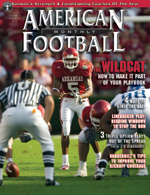AMERICAN FOOTBALL MONTHLY THE #1 RESOURCE FOR FOOTBALL COACHES
Article CategoriesAFM Magazine
|
Takeaway! More and More Teams are Using The Strip To Create Turnoversby: Steve Dorsey© More from this issue Stripping the football from an opposing running back or receiver is not a new concept. Some players, such as former Giants Hall of Fame linebacker Lawrence Taylor, included it their defensive tactics long before the NFL owners made the strip legal in 2002. More than ever though, defensive players are being coached about stripping the ball and successfully implementing it in game situations. Colts wide receiver Pierre Garcon’s strip of safety Ed Reed following a Peyton Manning interception in the AFC Divisional playoffs in January was the defining play in the Colts’ 20-3 win against the Ravens. The Saints produced a highlight reel of the art of the strip in their victory against the Vikings in the NFC Championship game, literally “punching” their ticket to the Super Bowl. The strip no longer is a desperation tactic used only ....The full article can only be seen by subscribers. Subscribe today!
|
|
|||||||
| HOME |
MAGAZINE |
SUBSCRIBE | ONLINE COLUMNISTS | COACHING VIDEOS |
Copyright 2025, AmericanFootballMonthly.com
All Rights Reserved





